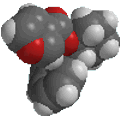 |
Chapter 15: Alcohols, Diols
and Thiols |
 |
Alkoxymercuration-Demercuration
of Alkenes
(review of Chapter 14)
 Reaction type: Electrophilic
Addition
Reaction type: Electrophilic
Addition
Summary
- Overal transformation C=C
to H-C-C-OR
- Typical reagents are mercury
acetate, Hg(OAc)2 in ROH /
THF
- Unfortunatley, mercury compounds
are generally quite toxic
- Regioselectivity predicted by
Markovnikov's rule
- The reaction is not stereoselective
- Reaction proceeds via the formation
of a cyclic mercurinium ion

- The mercurinium ion is opened
by the attack of alcohol to complete the alkoxymercuration.
- When the alcohol attacks, it
does so at the more highly substituted carbon.
- Demercuration is effected
by a reduction using sodium borohydride, NaBH4
QUESTIONS
Are rearrangements a problem
with this process ? ANSWER
Why does the alcohol attack the more
highly substituted carbon ? ANSWER
Related reactions

